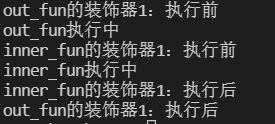总结:先调用的在里面,后调用的在外面,实际上是函数返回的机制:栈。
参考连接:
这篇文章,帮助你初步理解装饰器
两个装饰器
from functools import wraps
def decorator_name(a_func):
@wraps(a_func)
def wrapTheFunction(*args):
print(a_func.__name__ +"的装饰器1:执行前")
a_func(*args)
print(a_func.__name__ +"的装饰器1:执行后")
return wrapTheFunction
def decorator_args(a_func):
@wraps(a_func)
def wrapTheFunction(*args):
print(a_func.__name__ +"的装饰器2:执行前")
a_func(*args)
print(a_func.__name__ +"的装饰器2:执行后")
return wrapTheFunction
同一个函数调用多个装饰器
@decorator_name
@decorator_args
def com_fun(*args):
print("com_fun函数求和:",sum(args))
if __name__=="__main__":
# 下面2条语句等价
com_fun(1,2)
decorator_name(decorator_args(com_fun(1,2)))
执行com_fun()的结果:

嵌套函数调用同一个装饰器
内部的函数先被装饰器修饰,被外部的函数包围。
@decorator_name
def out_fun():
print("out_fun执行中")
inner_fun()
@decorator_name
def inner_fun():
print("inner_fun执行中")
执行out_fun()的结果:
